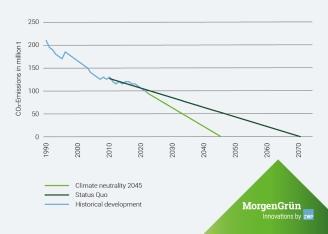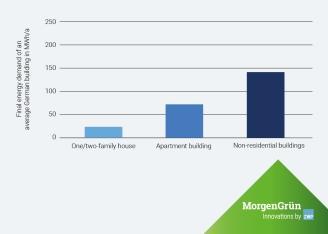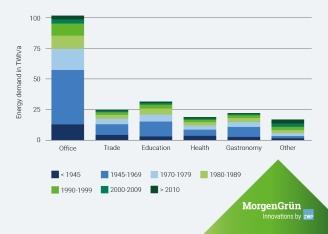If the pace of carbon emission savings in the building sector remains the same as in the last ten years, the building sector will not be climate-neutral until 2070 (see Fig. 1)1. However, decarbonising the building stock is crucial to achieving the goal of climate neutrality by 2045. This is mainly because over 90 % of existing buildings will still be in use in 2045 and beyond. In this article, we therefore answer the following questions:
- What is the share of different residential and non-residential building types in the energy demand and carbon emissions of the building stock?
- What role do the different building types play on the way to climate-neutral building stock?
- What aspects should be given particular attention to in the residential and non-residential sectors in order to implement effective and cost-efficient energy modernization measures and achieve significant carbon emission savings?

Fig. 1: Development of annual carbon dioxide emissions in the building sector and possible future developments [1]
Germany is built: The greatest potential for carbon emission savings lies in existing buildings! But where exactly?
Most carbon emissions in the building sector come from existing buildings. In Germany, only around 5.4 new buildings, that meet high energy standards are constructed every year for every 1,000 existing buildings. The major challenge therefore lies in the energy modernisation of existing buildings.
Almost 20 million residential buildings in Germany require 69% of the final energy of the building sector and thus cause 77% of emissions. In comparison, only around 2 million non-residential buildings consume 31% of final energy and are responsible for 23% of emissions. An average single-family home requires approx. 24 MWh of final energy per year, an apartment building 72 MWh and a non-residential building 141 MWh5. The energy demand per non-residential building is therefore significantly higher, which indicates a particularly high savings potential per building.

Fig. 2: Average final energy requirements of average German buildings [5]
Residential building stock: standardised modernisation measures possible
The 20 million residential buildings are relatively homogeneous in terms of their use and size. This makes it possible to develop standardised modernisation measures for certain building types based on building age classes, modernisations already carried out and location factors (e.g. connection to existing heating networks).
Various institutions have already developed standardised measures. Although these must be adapted to the respective buildings, they provide valuable guidance for owners. The standards help to identify sensible measures and better estimate investments and operating costs. They can also be used by politicians and planning and trade companies to strategically align funding and business models.
This means that the potential for sensible modernisation measures in the German residential building stock can be exploited on a large scale.
Non-residential buildings: Heterogeneity as a particular challenge
In contrast to residential buildings, the stock of non-residential buildings is much more diverse in terms of use, cubature and size. This heterogeneity makes it difficult to develop standardized modernization measures. Nevertheless, non-residential buildings can be roughly divided into main uses and building age classes. Fig. 3 shows the heating and cooling requirements of all German non-residential buildings for the respective uses and age categories6.
Office buildings offer particularly high savings potential due to their large number and age. In addition, around 75 % of the energy demand in each usage category is accounted by buildings that were built before 1980, i.e. before the first thermal insulation regulations. We can therefore expect high savings potential in these older buildings. This is in line with the frequently quoted statement that 35 % of buildings in the EU are more than 50 years old and 75 % are classified as energy inefficient7.

Fig. 3: Heating and cooling requirements of German residential and non-residential buildings [6]
Additional challenges include specific requirements such as cooling demand, mechanical ventilation and widely varying demand structures. Measures on the building envelope not only reduce the heating demand but can also increase the cooling demand and/or cooling load peaks. Ventilation systems make a significant contribution to energy requirements and should be optimally adapted to the use of the building.
In many non-residential buildings, large roof surfaces offer great potential for solar power generation, with electrical storage systems playing an increasingly important role (higher own use of renewable energies and potential for grid serviceability). Thermal storage systems are also relevant, as they make it possible to use smaller and more cost-effective heat supply devices such as heat pumps.
The development of optimal modernisation measures for non-residential buildings is a complex and challenging task due to the wide range of influencing factors. Measures on the building envelope, the replacement of heat and cooling generators, the integration of storage systems and adjustments to heat transfer systems (such as new radiators) must be precisely coordinated to transfer the building towards climate neutrality in a cost-efficient manner. It also often makes sense to implement the measures in a staggered manner in a so-called modernisation roadmap to optimally balance investments and efficiency gains.
Autor: Dr.-Ing. Jan Richarz (MorgenGrün,
Senior Consultant building modernisation & decarbonisation industry)
References
1 Own calculation, Data source: Umweltbundesamt (2023). Treibhausgasemissionen in Deutschland
2 Sandberg et al. (2016). Dynamic building stock modelling: Application to 11 European countries to support the energy efficiency and retrofit ambitions of the EU. Energy and Buildings, 132: 26–38
3 Own calculation, Data sources: Destatis (2022). Baufertigstellungen neuer Gebäude: Deutschland, Jahre, Gebäudeart, Energieverwendung, Energieart; Destatis (2022) Fortschreibung des Wohngebäude- und Wohnungsbestandes – Lange Reihen von 1969 bis 2021
4 Dena (2025). Dena-Gebäudereport 2025
5 Own calculations with data from Dena-Gebäudereport 2025 und Dena-Gebäudereport 2024
6 Own figure, Data source: Pezzutto et al., Hotmaps Project, D2.3 WP2 Report – Open Data Set for the EU28, 2018
7 Economidou et al. (2011) Europe’s buildings under the microscope – a country-by-country review of the energy performance of buildings
8 Hörner et al. (2022). Final report research project EnOB dataNWG: Forschungsdatenbank Nichtwohngebäude
Summary
Residential buildings
- Homogeneous structures enable standardised modernisation measures.
- Low savings per building, but great scaling potential.
- Standardised measures provide orientation and support funding strategies.
Non-residential buildings
- Heterogeneity requires individual modernisation concepts
- Higher savings potential per building, but lower number in existing buildings.
- Special challenges due to specific usage requirements.
More on this soon ...
There are not just two, but 21 million non-residential buildings in Germany8. However, not all of them are covered by the Building Energy Act (GEG). Buildings that are mainly used for production, for example, are excluded.
In the next part of this article, we will take a closer look at these production buildings!
